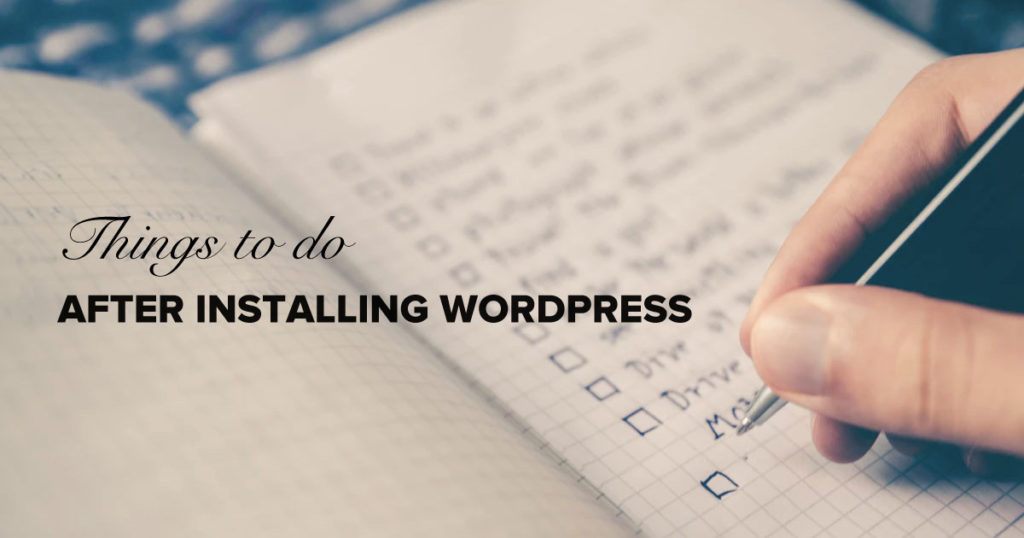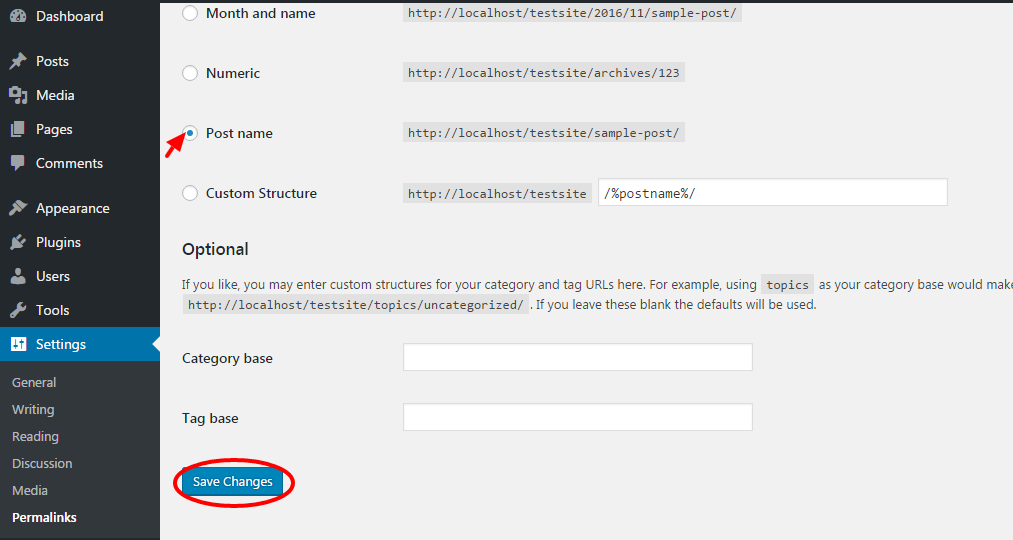10 Things To Do After Installing WordPress
Last updated September 1, 2019 · Arpita

It’s great to have WordPress installed. But the common question asked by the beginners is What do you do after installing WordPress? In this post I’ll guide you to 10 most essential things to be done after installing WordPress.
Here are 10 Things to do after installing WordPress:
1. Configure General Settings
General Settings include Site Title, Tagline, User Registration option, Timezone and Favicon which have to be configured. Go to Settings> General option on the Dashboard.
Change the Site Title, Tagline and TimeZone:
Site Title and Tagline should be such that it resembles your site, as it will appear in the Google search results. Default site tagline is “just another WordPress site”.
Scroll down to set up the TimeZone to your local time. Doing so will enable you to schedule your Posts according to your Timezone.
Now add a Favicon to your Website.
What exactly this Favicon is and how important it is for your website?
Favicon is a small icon that appear next to your website title in the browser. This icon will later help you to gain recognition for your website. People will start identifying you where ever they see this icon. Favicon also help you build brand recognition and trust among audiences.
To add the Favicon. Go to Appearance> Customize and click to Site Identity tab. Simply click on the Select File button and upload icon to your website. This is all, now you can preview your site and see the favicon write in next to your site title in the browser.
In order to avoid spam posts, disable Users Registration.
After customizing all these settings, Save Changes.
2. Delete Default Content
WordPress on installation provides some default content like a default Page, a default Post, and a default Comment. It is highly recommended that you discard this default content before proceeding. You can delete the default Page (Sample Page), default Post (Hello World) and Comment using options on the Dashboard.
3. Configure Permalinks:
Permalinks refer to the URLs of the content you publish on your website. WordPress, by default, provides a permalink which is something like this:
http://localhost/testsite/?p=123
The default permalink is not searched engine friendly. To make permalink search engine friendly, choose post name which is the most common. Click Permalinks option from Settings on Dashboard. Select post name and save changes.
4. Install SEO and Analytics Plugins
Search engines are a major source of traffic for most websites. SEO plugins make your blog search engine friendly and improve the SEO of their WordPress sites. The two popular plugins are – Yoast SEO, All in SEO
If you want information about who visits your site and their response to your site, then Google Analytics is the right choice. It also gives detailed information about website traffic.You have to initially sign up and then integrate Google Analytics to your site.
Although there are plenty of plugins available to track your site’s performance, the recommended one is Google Analytics for WordPress. It is easy for beginners as well as experts to use.
5. Setup Automated Backup
Backups pacify your mind and can save you in problematic situations when your site gets hacked. There are several free and paid Backup Plugins for WordPress, and most of them are fairly easy to use. It’s always good to backup your site and be on the safe side. The best way is to use Backup Plugins. To list a few free Backup Plugins WP Time Capsule, BackWPup, UpdraftPlus, and WP-DP Backup. Or you can use a Premium Backup Solution like BlogVault that takes care of Backups, Staging, Migration, and Security – all from one Dashboard!
6. Secure Your Website
WordPress is a robust and secure framework, but this doesn’t protect it from hackers. Weak passwords are just one of the many factors that make your site prone to getting hacked. Because of this, having an extra layer of security can always be beneficial. Here are some of the best WordPress security plugins to help you protect your site: MalCare, iThemes Security, WordFence, Sucuri Security, SecuPress.
7. Improve Page Load Speed
On a WordPress site, excessive load times can limit your traffic and results in poor SEO. It will also pull down your Google search rank and decrease your website’s overall potential. However, a free or low cost caching plugin can easily provide an optimal solution to this problem.
Last but not the least, they’ll make visitors more likely to stay on your site. By using a caching plugin, entire HTML pages are saved in the cache already present and ready to be delivered quickly. Here’s the lineup: WP SuperCache, WP Fastest Cache, WP Rocket and Zen Cache
8. Configure Antispam Plugins
Controlling WordPress comment spam can be done with the help of plugins. Also with a little bit of tweaking the discussion settings in WordPress. Spam comes into your website by unwanted messages creeping in which can be controlled by using Antispam Plugins. To name a few: Akismet, Antispam Bee, GrowMap Anti-SpamBot.
9. Optimize Images
High-resolution images have a major impact on load time. They slow down page speed because of their large file size. If image size can be reduced without losing its quality, then nothing like that. Optimizing images also boosts your SEO.
To solve this issue, Image Optimization plugins come to rescue. They compress images, thus optimizing them. To name a few of them: EWWW Image Optimizer, WP-Smush, Short Pixel Image Optimizer, Imagify.
10. Add Contact Form
Contact Form plugins allow you to customize the form and also mail contents using simple markup. They block all automated spammers. No templates to mess with. Designers are the most benefited by contact form plugins. Examples are WPForms, Gravity Forms, Ninja Forms.
I hope the tips mentioned in the article are helpful for you. Let me know in the comments below if you find any difficulty to configure any settings. You can also suggest an addition to the list for our readers to be taken care of.





You would install this?
SEO Smart Links
This plugin hasn’t been updated in over 2 years. It may no longer be maintained or supported and may have compatibility issues when used with more recent versions of WordPress.
Setup SSL
If we leave aside the the need for branding on websites that are mostly for very small concerns, favicons aren’t visible on the great majority of mobiles, and mobiles are the most used viewing platform, by far. So favicons are largely irrelevant.
I agree that it’s not a big deal but, branding matters. Some themes add their own Favicons. So, it’s better to add a custom one instead of getting something completely irrelevant.
You definitely have a point, but nothing screams “amateur” more than the default favicon from your hosting company or the theme you’re using. I think the 10 seconds it takes to add a custom favicon is very important for anyone who wants a professional-looking website.
I’d remove SEO Smart Links as a recommended plugin. Hasn’t been updated for over 2 years and has more 1* ratings than 5*
Also, highly recommend WP Rocket for speed.
Thanks Dave. Just updated the list 🙂
Imagify also good for compressing images.
Thanks for the list puneet
Thanks John. Added Imagify to the list.
I would add Secupress and Imagify both from the awesome guys from WP Rocket! – nice list!
Thanks. Added them to the list.
Is it just me but one of the first things I do is remove that tedious “Hello Dolly” plug in , (or whatever it s called)
– might have been a not very amusing “joke” at one time but seems pretty pointless/annoying to me.
Bulletproof security seems to cover a lot of ground. I still wound up conceiving some malware but only because I used WP All in One Migration Tool to restore a previous database that was still infected from last time. Never use this. It may have a backdoor that injects a script that redirects your users on ALL your sites index.php pages. It’s creepy. Either that or I was infected before and I just reinfected myself by restoring through that plugin. Either way keep a watchful eye out.
This is incredibly useful! Lots of tips and I learned a couple of new things! Thanks for sharing…